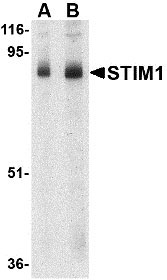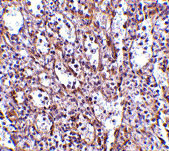STIM1 Antibody
- 产品详情
- 实验流程
- 背景知识
Application
| WB, E, IHC-P |
|---|---|
| Primary Accession | Q13586 |
| Other Accession | NP_003147, 21070997 |
| Reactivity | Human, Mouse, Rat |
| Host | Rabbit |
| Clonality | Polyclonal |
| Isotype | IgG |
| Calculated MW | 77423 Da |
| Concentration (mg/ml) | 1 mg/mL |
| Conjugate | Unconjugated |
| Application Notes | STIM1 antibody can be used for detection of STIM1 by Western blot at 1 - 2 µg/mL. Antibody can also be used for immunohistochemistry starting at 2.5 µg/mL. |
| Gene ID | 6786 |
|---|---|
| Other Names | STIM1 Antibody: GOK, TAM, IMD10, D11S4896E, GOK, Stromal interaction molecule 1, stromal interaction molecule 1 |
| Target/Specificity | STIM1; At least two isoforms of STIM1 are known to exist; this antibody will detect only the larger form. This STIM1 antibody is predicted to have no cross-reactivity to STIM2. |
| Reconstitution & Storage | STIM1 antibody can be stored at 4℃ for three months and -20℃, stable for up to one year. As with all antibodies care should be taken to avoid repeated freeze thaw cycles. Antibodies should not be exposed to prolonged high temperatures. |
| Precautions | STIM1 Antibody is for research use only and not for use in diagnostic or therapeutic procedures. |
| Name | STIM1 |
|---|---|
| Synonyms | GOK {ECO:0000303|PubMed:9377559} |
| Function | Acts as a Ca(2+) sensor that gates two major inward rectifying Ca(2+) channels at the plasma membrane: Ca(2+) release- activated Ca(2+) (CRAC) channels and arachidonate-regulated Ca(2+)- selective (ARC) channels (PubMed:15866891, PubMed:16005298, PubMed:16208375, PubMed:16537481, PubMed:16733527, PubMed:16766533, PubMed:16807233, PubMed:18854159, PubMed:19182790, PubMed:19249086, PubMed:19622606, PubMed:19706554, PubMed:22464749, PubMed:24069340, PubMed:24351972, PubMed:24591628, PubMed:25326555, PubMed:26322679, PubMed:28219928, PubMed:32415068). Plays a role in mediating store- operated Ca(2+) entry (SOCE), a Ca(2+) influx following depletion of intracellular Ca(2+) stores. Upon Ca(2+) depletion, translocates from the endoplasmic reticulum to the plasma membrane where it activates CRAC channel pore-forming subunits ORA1, ORA2 and ORAI3 to generate sustained and oscillatory Ca(2+) entry (PubMed:16208375, PubMed:16537481, PubMed:32415068). Involved in enamel formation (PubMed:24621671). |
| Cellular Location | Cell membrane; Single-pass type I membrane protein. Endoplasmic reticulum membrane; Single-pass type I membrane protein. Cytoplasm, cytoskeleton. Sarcoplasmic reticulum. Note=Translocates from the endoplasmic reticulum to the cell membrane in response to a depletion of intracellular calcium and is detected at punctae corresponding to junctions between the endoplasmic reticulum and the cell membrane (PubMed:16005298, PubMed:16208375, PubMed:18854159, PubMed:19182790, PubMed:19249086). Associated with the microtubule network at the growing distal tip of microtubules (PubMed:19632184). Colocalizes with ORAI1 at the cell membrane (PubMed:27185316). Colocalizes preferentially with CASQ1 at endoplasmic reticulum in response to a depletion of intracellular calcium (PubMed:27185316) |
| Tissue Location | Ubiquitously expressed in various human primary cells and tumor cell lines. |
For Research Use Only. Not For Use In Diagnostic Procedures.
Provided below are standard protocols that you may find useful for product applications.
BACKGROUND
STIM1 Antibody: In T lymphocytes, the sole pathway for Ca2+ entry following antigen-receptor binding is through store-operated Ca2+-release-activated Ca2+ (CRAC) channels. These channels are made up of the pore-forming subunit ORAI1 and the stromal interaction molecule 1 (STIM1), a protein that functions as a Ca2+ sensor and activates the CRAC channels, migrating to the plasma membrane from endoplasmic reticulum (ER)-like sites which act as the Ca2+ store. A related molecule, STIM2, acts to inhibit the STIM1-mediated store-operated Ca2+ entry, and can form complexes with STIM1, suggesting they may play a coordinated role in controlling Ca2+ entry.
REFERENCES
Luik RM and Lewis RS. New insights into the molecular mechanisms of store-operated Ca2+ signaling in T cells. Trends Mol. Med. 2007; 13:103-7.
Feske S, Gwack Y, Prakriya M, et al. A mutation in Orai1 causes immune deficiency by abrogating CRAC channel function. Nature 2006; 441:179-85.
Zhang SL, Yu Y, Roos J, et al. STIM1 is a Ca2+ sensor that activates CRAC channels and migrates from the Ca2+ store to the plasma membrane. Nature 2005; 437:902-5.
Spassova MA, Soboloff J, He L-P, et al. STIM1 has a plasma membrane role in the activation of store-operated Ca2+ channels. Proc. Natl. Acad. Sci. USA 2006; 103:4040-5.
终于等到您。ABCEPTA(百远生物)抗体产品。
点击下方“我要评价 ”按钮提交您的反馈信息,您的反馈和评价是我们最宝贵的财富之一,
我们将在1-3个工作日内处理您的反馈信息。
如有疑问,联系:0512-88856768 tech-china@abcepta.com.























 癌症的基本特征包括细胞增殖、血管生成、迁移、凋亡逃避机制和细胞永生等。找到癌症发生过程中这些通路的关键标记物和对应的抗体用于检测至关重要。
癌症的基本特征包括细胞增殖、血管生成、迁移、凋亡逃避机制和细胞永生等。找到癌症发生过程中这些通路的关键标记物和对应的抗体用于检测至关重要。 为您推荐一个泛素化位点预测神器——泛素化分析工具,可以为您的蛋白的泛素化位点作出预测和评分。
为您推荐一个泛素化位点预测神器——泛素化分析工具,可以为您的蛋白的泛素化位点作出预测和评分。 细胞自噬受体图形绘图工具为你的蛋白的细胞受体结合位点作出预测和评分,识别结合到自噬通路中的蛋白是非常重要的,便于让我们理解自噬在正常生理、病理过程中的作用,如发育、细胞分化、神经退化性疾病、压力条件下、感染和癌症。
细胞自噬受体图形绘图工具为你的蛋白的细胞受体结合位点作出预测和评分,识别结合到自噬通路中的蛋白是非常重要的,便于让我们理解自噬在正常生理、病理过程中的作用,如发育、细胞分化、神经退化性疾病、压力条件下、感染和癌症。







